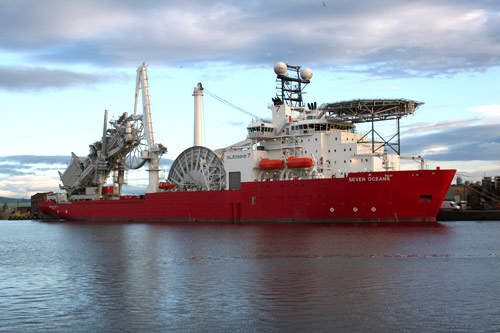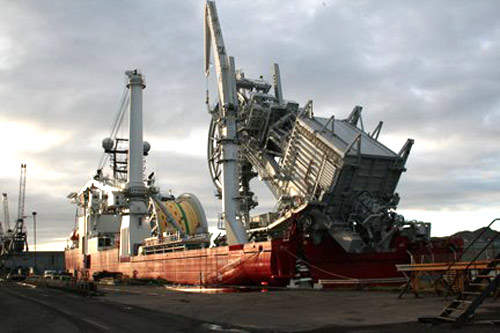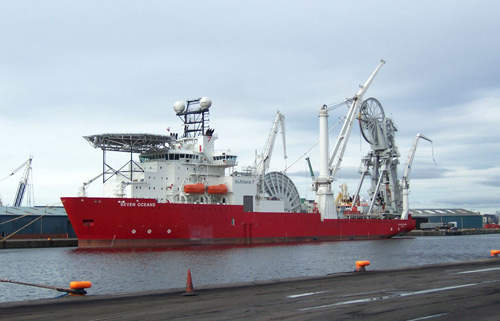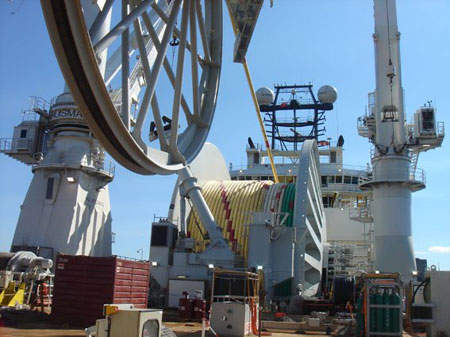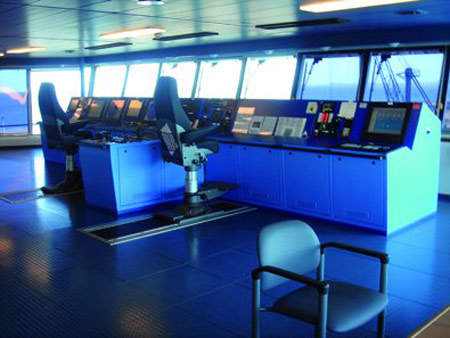The Seven Oceans is the first of a pair of modern reel-lay vessels being built for Subsea 7 at the Merwede yard in the Netherlands. Its sister ship is the Seven Seas. The vessel has an overall length of 157.3m, a 28.4m breadth and the depth to the maindeck is 12.5m. It has a design draught design of 7.5m and a deadweight of 10,930t. The cargo deck has a main deck area of 650m² and a strength of 10t/m².
The helideck, control facilities and accommodation are at the bow. The Seven Oceans is fitted with a helideck approved for Super Puma and S61 helicopter operations. Below this, the bridge includes an array of navigation equipment as well as Inmarsat B and KU-band systems.
The KU-band system has the option to be converted to C band as operational requirements demand. The vessel also has a comprehensive survey system including current profiler, multibeam echo sounder and heading reference system.
The vessel has accommodation 120 persons. This includes three captain-class cabins, three large and two standard officer-class cabins, 12 single cabins, 48 double cabins, a four-man cabin and a hospital.
PIPELAY SYSTEM
The high-specification pipelay spread was being designed and manufactured by Huisman-Itrec in the Netherlands. At the centre of the vessel is the 3,500t main deck-mounted storage and deployment reel. An optional 250t piggyback reel can be fitted as required. A lay ramp system is permanently installed for the deployment of a range of flexible products and it has a top tension capacity of 400t. The main reel can stow products from 6in to 16in in diameter.
The lay ramp system comprises of an aligner wheel, pipe straightener, tensioner, hold back clamp, (600t) roller box, two abandonment and recovery sheaves and two ramp elevators. There are 450t and 80t abandonment and recovery reels.
The pipelay operations are assisted by the cranes. The main deck has a capacity of 350t at 13m (double fall) or 200t at 25m (single fall). In harbour, this capacity can be increased to 400t at 16.5m (double fall) or 200t at 32m (single fall). There are also two auxiliary deck cranes – one 40t at 16m (12t at 40m) and the other with a capacity of 12t at 25m. The vessel also incorporates a 120t at 25m whipline.
OFFSHORE VESSEL OPERATION
Advanced offshore vessels require a high speed to enable them to get to the desired location around the world as quickly as possible, minimising downtime. They also require high tank capacities to allow them to carry out these long journeys without having to call into port to refuel. Another necessary requirement for pipelay operations is the ability to stay on station in harsh weathers.
The Seven Oceans has six 3,360kW diesel electric engines which provide the power for the thrusters as well as the pipelay operations.
For propulsion, the ship has three 2,950kW stern azimuth thrusters, two 2,400kW retractable bow azimuth thrusters and a 2,200kW bow tunnel thrusters, all provided by Wartsila. This gives a total thruster power of 15,850kW and enables a service speed of in excess of 13kt.
The ship is equipped with a DP (AA) class two dynamic positioning system. The Kongsberg Simrad SDP 22 dynamic positioning system is supported by three DGPS reference Systems, two HiPAP systems, a taut wire and a fanbeam. The main tanks can hold 2,600m³ of marine gasoil as well as 1,200m³ of fuel oil. It has 600m³ of fresh water, 4,500m³ of ballast water and 42m³ of lube oil.
The Seven Oceans is classified by Lloyds Register with the notation +100A1, +LMC, UMS, DP (AA), CAC(3), EP, ICC and UD.

